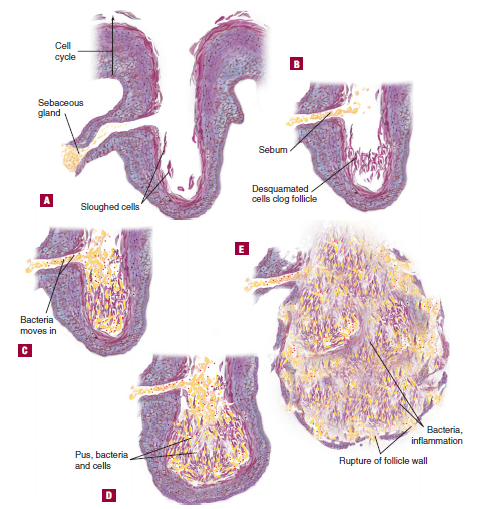Introduction
Acne is very popular topic in cosmetic dermatology, Although acne is not typically considered to be a “cosmetic” problem, its highly visible nature makes it a very common complaint among cosmetic patients who are by definition concerned about their appearance. Acne can often have a profound psychological impact on patients.
Causes of Acne:

Comedogenesis and acnegenesis are actually discrete processes, but they are usually associated with one another, with the latter often succeeding the former. Inflammation of the follicular epithelium, which loosens hyperkeratotic material within the follicle creating pustules and papules, characterizes acnegenesis , Comedogenesis is best described as a non inflammatory follicular reaction manifested by a dense compact hyperkeratosis of the follicle, and usually precedes acne genesis. Because the etiology of such lesions varies from person to person and within individuals also, it is difficult to categorically identify or isolate a basic cause of acne; however, three principal factors have been identified. The primary causal factors in acne work interdependently and are mediated by such important influences as heredity and hormonal activity.
Sebaceous Gland Hyperactivity
Sebum is continuously synthesized by the sebaceous glands and secreted to the skin surface through the hair follicle pore. The excretion of lipids by the sebaceous glands is controlled hormonally. The sebaceous glands are located all over the body but are largest and most numerous in the face, back, chest, and shoulders. These glands become more active during puberty because of the increase in androgens, particularly testosterone, which spurs sebum production. This imbalance between sebum production and the secretion capacity leads to a blockage of sebum in the hair follicle followed by inflammation.

Changes in Follicular Keratinization
Changes in Follicular Keratinization In the lower portion of the follicular infundibulum, the normal process of keratinization occurs in the same way that it occurs on the skin’s surface. This maturing of keratinocytes and subsequent exfoliation into the follicle marks the beginning of the formation of comedones. In acne patients, these keratinocytes tend to stick together because of the effects of positive and negative charges, the actions of trans glutaminase, and the stickiness of sebum. The clumped keratinocytes block the pore/follicle, creating a blackhead if the pore is open (“open comedone”) or a whitehead if it is closed (“closed comedone”) The clogged pore is a
great nutritional source for bacteria so Propioni bacterium acnes gravitate to the blocked pores. The immune system recognizes the presence of bacteria and mounts an immune response resulting in redness, pus, as well as inflammation, and the typical “pimple” results. Most of the inflammation, however, is likely due to inflammatory mediators that are released when bacteria digest sebum.
The Influence of Bacteria
P. acnes has been cited as the cause of acne because it is typically present in teenagers with acne and not those without acne. However, P. acnes is commonly found in the facial flora of adults with or without acne. The exact role of bacteria is therefore unclear. It is known that sebum accumulation because of excess lipid secretion and hyperkeratosis at the infundibulum leads to an increase in P. acnes around the hair follicles. The presence of the bacteria is likely not a direct cause of acne breakouts, though. It is more likely that the inflammation seen in acne is caused by free fatty acids that result from the breakdown of triglycerides in the sebum owing to bacterial lipases
TREATMENT
NORMALIZING KERATINIZATION/EXFOLIATION
The first step in controlling acne is to prevent the exfoliated keratinocytes from sticking together. This can be achieved by mechanical peeling (microdermabrasion) ,Chemical skin peeling , Retinoid creams, acne control face wash ,adapalene creams , Moisturisation.
Eliminating p.acnes bacteria
The use of antibiotics clindmycin erythromycin or benzoyl peroxide attacks the bacterial population there by decreasing the level
of inflammatory extracellular products
Removing Materials that clogs the pore
chemical peels BHA
Attacking inflammatory responce
Decreasing Level of sebum
All of this can be achieved By light therapy which help in Exfoliation, eliminating bacteria, Shrinks pores.

I was pretty pleased to discover this great site. I want to to thank you for ones time due to this fantastic read!! I definitely appreciated every part of it and I have you book marked to look at new stuff on your web site.